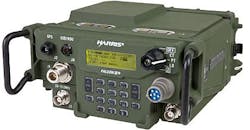Army chooses Harris to provide voice, data, and video networking to the battlefield front lines
ABERDEEN PROVING GROUND, Md., 26 Sept. 2013. U.S. Army military communications experts needed multi-channel tactical radios for military vehicles to extend voice, data and imagery services from brigade and battalion radio networks to companies and platoons operating in the field. They found their solution from the Harris Corp. RF Communications segment in Rochester, N.Y.
Officials of the Army Contracting Command at Aberdeen Proving Ground, Md., awarded a potential $140.7 million contract to Harris RF on Tuesday to design and build the Mid-Tier Networking Vehicular (MNVR) radio, which will host Joint Tactical Networking Center (JTNC) waveforms and fulfill the Army's need for a tactical radio networking bridge to connect upper-level commanders with fighting forces on the forward edge of the battlefield.
The two-channel MNVR solution is based on the Harris Falcon III AN/PRC-117G multiband networking radio. The MNVR system provides an extension of data services from the upper tactical network at brigade and battalion to the lower tactical network at company and platoon echelons.
The advanced network waveforms distribute data and imagery with information assurance protection and automatic routing across complex terrain, Army officials say.
The MNVR capability consists of modular radios capable of running software-defined waveforms, which operate as nodes in a network to ensure secure wireless communication and networking services for mobile and stationary forces.
This supports mission command, sensor-to-shooter, sustainment and survivability applications on military combat vehicles and other tactical platforms.
Through software reconfiguration, these radios emulate current force radios and operate new Internet protocol-based networking waveforms offering increased data throughput through self-forming, self-healing, and managed communication networks. MNVR also provides a dynamic, scalable, on-the-move network architecture, with enhanced capability to exchange voice, data, and video simultaneously.
The Army chose Harris to provide the MNVR in a competitive procurement over three other bidders, Harris officials say. The contract includes an initial order for as many as 232 MNVR radio systems for the upcoming Network Integration Evaluation 15.1 in fall 2014.
The Harris AN/PRC-117G radio, which is at the heart of the MNVR system, helps provide warfighters with situational awareness of the battlefield through wireless, high-bandwidth communications, enabling applications such as streaming video, simultaneous voice and data feeds, collaborative chat, as well as combat network radio capabilities and connectivity to secure networks.
The AN/PRC-117G gives has more than 10 times the processing power of currently fielded Type-1 manpack radios, Harris officials say. It provides continuous coverage in the 30 MHz to 2 GHz frequency bands, and offers software upgradeability.
The radio is certified to the U.S. Joint Tactical Radio System (JTRS) standards, is NSA Type-1 certified, JITC certified for narrowband interoperability assessment and compliance with DAMA standards, and includes SINCGARS, Havequick II, VHF/UHF AM and FM, High Performance Waveform (HPW), MIL-STD-188-181B satellite communications (SATCOM).
The radio uses the Harris Adaptive Networking Wideband Waveform (ANW2) for high bandwidth data operation, and operates off a standard battery while maintaining peak transmit power of 10 Watts VHF and 20 Watts UHF Harris has deployed more than 45,000 Falcon III wideband radios around the world, company officials say.
On the MNVR contract, Harris will do the work at various locations. Funding will be determined with each order. For more information contact Harris RF Communications online at http://rf.harris.com, or the Army Contracting Command at www.army.mil/acc.

